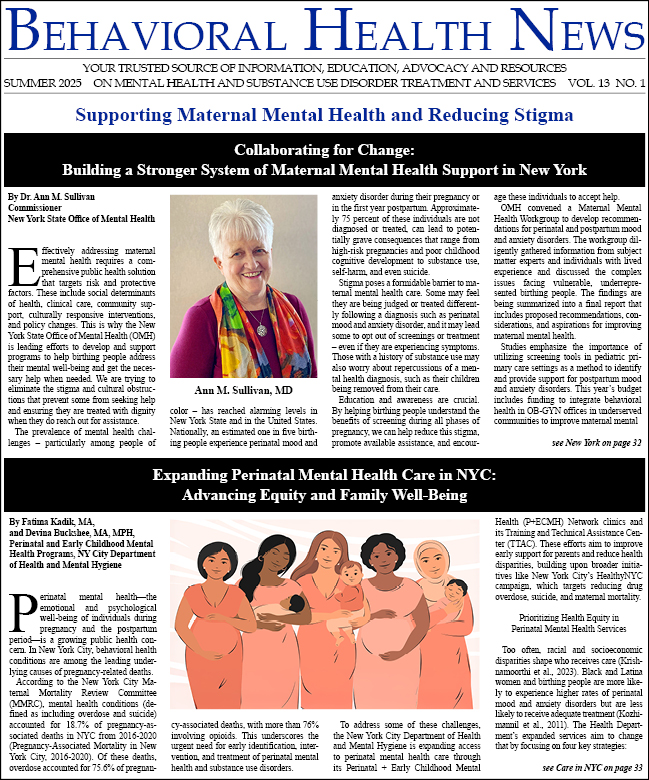Stigma around mental illness remains an all-too-common occurrence, despite the increased availability of information about mental illnesses and the national discourse on prioritizing mental well-being. While we have made great strides in understanding mental illness, false perceptions of weakness, violent behavior, or personal failings still remain. Fortunately, educating individuals on mental illness has proven a viable means of combatting stigma.

Rola Aamar, PhD
A study conducted in Scotland (Committee on the Science of Changing Behavioral Health Social Norms, 2016) examining a two-year campaign aimed at normalizing mental health to the public garnered interesting results. After the campaign’s conclusion, researchers found a 17% decrease in the perception that individuals with mental illnesses are dangers and an 11% decrease in individuals who felt the public needed protection from those with mental illnesses.
Clearly, education can help decrease stigma. In this article, we’ll discuss certain types of content that research has shown to be effective in these educational campaigns.
Words Matter
The language we use when discussing mental illness and substance use disorders (SUDs) has a profound impact on the levels of stigma within a society. Stigma itself is a negative view of people based upon certain characteristics or criteria. And stigmatizing language only serves to reinforce these negative views, causing psychological harm to those being stigmatized. For instance, studies (Volkow et al, 2021) have found that when individuals with alcohol use disorder (AUD) perceive large amounts of public stigma around their condition, they are 50% less likely to seek treatment. And, unfortunately, researchers have observed very similar results across populations with SUDs and mental illness.
In order to counteract these outcomes, behavioral health professionals must avoid using terms with negative connotations when discussing mental illness or addiction. More and more, research is illuminating just how impactful language can be. A study published in Neuropsychopharmcology (Volkow et al, 2021) showed that the use of non-stigmatizing and inclusive language can lead to a decrease in feelings of stigmatization.
To get started using non-stigmatizing language, focus on person-centered language. This type of language reflects that an individual’s health condition is only one part of their life, not a defining characteristic. For example, rather than calling someone an “alcoholic,” providers should use the term, “a person with AUD.” Another example would be replacing the word “schizophrenic” with “a person with schizophrenia.”
When trying to decide what language to use to describe a mental health condition, don’t be afraid to ask individuals living with that condition what terminology they prefer you use. Using inclusive language means understanding that different people talk about their mental health in different ways and adjusting the language you use to fit their needs.
As this type of person-centered language has proven to be less stigmatizing, it allows behavioral health organizations to not only provide treatment to persons served, but also craft more effective community outreach and education programs.
Shifting the Narrative Away from Biogenesis
It has been a common practice for some time to discuss biogenetic explanations for mental illness and SUDs as a means of removing blame from those living with these conditions. The original thought behind this type of discussion in educational settings was to demonstrate that mental illness was not a result of weakness or some sort of moral failing, but, rather, a medical condition.
Recent research (Kvaale et al, 2013), however, suggests that educational campaigns around mental illness and SUD should limit the information provided that highlights the genetic components of these conditions. While limited use of this type of information may be helpful in-patient education during treatment within specific settings, research has shown that its use in widespread community education campaigns has had the opposite of its intended effect.
Language that highlights genetic markers and other medically relevant information that pertains to an individual’s likelihood of developing mental illness may lead to several unintended and negative consequences. For one, this type of discussion can lead individuals without a diagnosed mental illness to see those with a diagnosed mental illness as different or even less than, which may inadvertently distract from the message of recovery. Additionally, discussion of biogenesis may cause those with a mental illness to feel as if their condition is biologically predetermined and, thus, recovery and healing are impossible tasks.
It’s time to shift the narrative to biopsychosocial components, rather than purely biomedical components. Patient education focused on the biopsychosocial components of a condition is an important part of understanding and addressing mental health needs. Biopsychosocial patient education can be a powerful tool because it helps individuals understand that while a condition may be complex, there are resources available in each domain of health that will help them navigate it.
Putting it All Together
Overcoming stigma is not an impossible task, but it will take time and effort. Through effective community outreach and education, behavioral health organizations can effectively reduce the instances of stigma in their areas.
As research has shown time and again, educating ourselves and others about mental health stigma is one of the most effective means of working toward a de-stigmatized world. To create effective education programs and outreach, however, it’s important that your organization understands the unique challenges of the populations that you serve and that you adhere to current literature and best practices on patient education and community outreach, some of which are shared here.
First, ensure that all your communications, both internal and external, include person-centered language. This language puts people at the center of the discussion, rather than mental health conditions, and thus allows organizations to educate the public on these conditions without implying there is something inherently wrong with those who live with these conditions. Additionally, by using person-centered language in your internal communications, your organization can practice effective self-education and create a culture of inclusivity.
Next, as research suggests, it may be time to move away from discussion of biogenetic explanations for mental illness; remove this language from your educational materials. This goes hand-in-hand with person-centered language. Just as organizations strive to focus on the whole person at the center of care, they should place the whole person at the center of their educational campaigns, rather than one domain of the conditions with which they live. One way to achieve this is by making sure that educational campaigns promote an understanding of the biopsychosocial model of health and provide resources and treatment options that address all three domains of health.
Finally, understand how the populations you serve are learning about mental health conditions, specifically from which social media outlets they receive their information about mental health. Be prepared to provide patient education that counters any misinformation they may receive through social media. Also, vet social media sources that are reliable and accurate and share their accounts with the individuals you serve. Directing them to specific posts or videos with information that may be relevant for them can help your patients understand that you support their use of social media to be more informed about mental health, and that you will be a partner in guiding them to accurate and helpful information.
References
- Committee on the Science of Changing Behavioral Health Social Norms; Board on Behavioral, Cognitive, and Sensory Sciences; Division of Behavioral and Social Sciences and Education; National Academies of Sciences, Engineering, and Medicine. Ending Discrimination Against People with Mental and Substance Use Disorders: The Evidence for Stigma Change. Washington (DC): National Academies Press (US); 2016 Aug 3. 4, Approaches to Reducing Stigma. Available from: https://www.ncbi.nlm.nih.gov/books/NBK384914/
- Volkow, N.D., Gordon, J.A. & Koob, G.F. Choosing appropriate language to reduce the stigma around mental illness and substance use disorders. Neuropsychopharmacol. 46, 2230–2232 (2021). https://doi.org/10.1038/s41386-021-01069-4
- Volkow, N.D., Gordon, J.A. & Koob, G.F. Choosing appropriate language to reduce the stigma around mental illness and substance use disorders. Neuropsychopharmacol. 46, 2230–2232 (2021). https://doi.org/10.1038/s41386-021-01069-4
- Kvaale EP, Gottdiener WH, Haslam N. Biogenetic explanations and stigma: a meta-analytic review of associations among laypeople. Soc Sci Med. 2013 Nov;96:95-103. doi: 10.1016/j.socscimed.2013.07.017. Epub 2013 Jul 31. PMID: 24034956.







I know many prefer “mental health condition” to “mental illness” as the latter can perpetuate the narrative of being inherently “sick”.